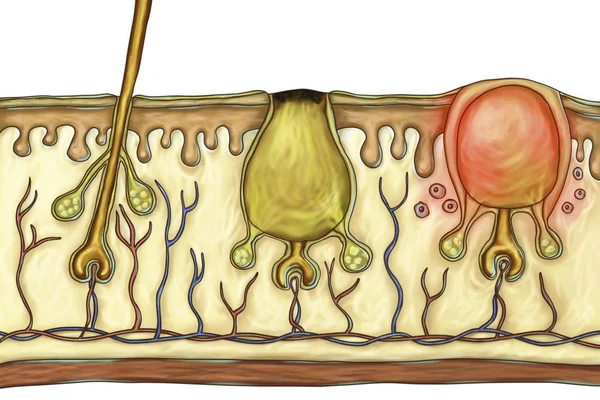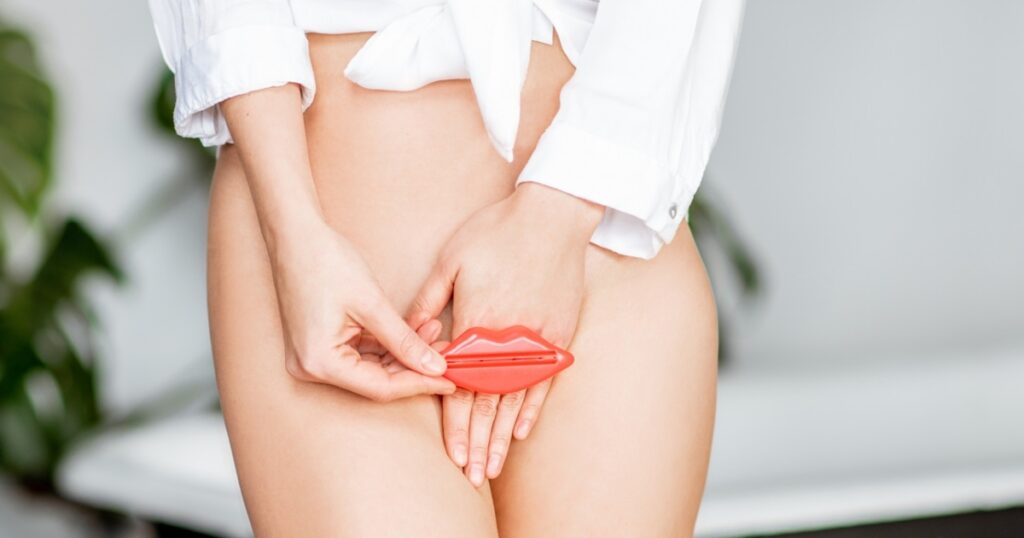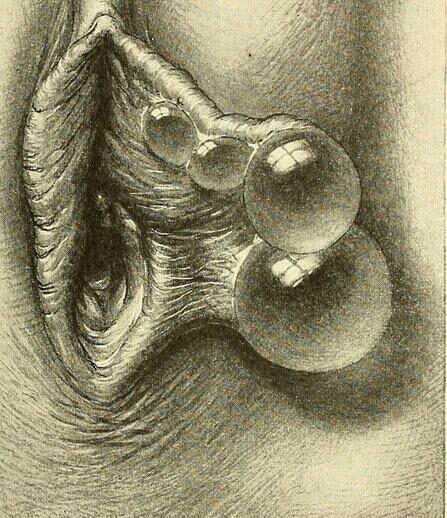Labial sebaceous cysts are small, non-cancerous lumps that form on the labia, the outer folds of the vulva. These cysts arise from sebaceous glands, which are responsible for producing sebum, an oily substance that lubricates the skin. When these glands become blocked, sebum accumulates, leading to the formation of a cyst.
Vulvar and vaginal cysts encompass a variety of types, each with distinct characteristics and origins. While labial sebaceous cysts are one type, other common cysts include:
- Bartholin’s Cysts: Form near the vaginal opening due to blocked Bartholin glands.
- Inclusion Cysts: Develop after trauma or surgery, trapping skin cells beneath the surface.
- Gartner’s Duct Cysts: Found along the vaginal walls, remnants from embryonic development.
Table of Contents
Toggle- Labial Sebaceous Cysts:
- Types of Vulvar and Vaginal Cysts
- Causes of Labial Sebaceous Cysts
- Symptoms of Labial Sebaceous Cysts
- Diagnosis of Labial Sebaceous Cysts
- Treatment and Management of Labial Sebaceous Cysts
- Prevention of Labial Sebaceous Cysts
- Outlook and Prognosis for Labial Sebaceous Cysts
- Living with Labial Sebaceous Cysts
- Conclusion
- Frequently Asked Questions (FAQs)
Labial Sebaceous Cysts:
- Labial sebaceous cysts are more specifically located on the labia and arise directly from the sebaceous glands.
- They are typically yellowish or white and filled with a greasy material.
Being aware of the variety and specifics of these cysts is essential for accurate diagnosis and effective treatment. Labial sebaceous cysts, in particular, require awareness due to their prevalence and potential discomfort for many women.
Types of Vulvar and Vaginal Cysts
Inclusion Cysts
Inclusion cysts typically form as a result of trauma or surgery, causing skin cells to become trapped under the surface. These cysts are generally small, smooth, and filled with a cheesy substance. They can occur anywhere on the vulva or in the vaginal canal and are usually painless unless they become infected.
Bartholin Gland Cysts
Bartholin gland cysts develop when the Bartholin glands, located near the vaginal opening, become blocked. These glands release a substance that coats and lubricates the vagina. When a duct is obstructed, it can lead to a buildup of fluid, forming a cyst. Bartholin gland cysts can range in size and may cause discomfort, especially if they become infected.
Sebaceous Cysts
Sebaceous cysts, including labial sebaceous cysts, form when sebaceous glands become blocked. These cysts are filled with sebum, an oily substance produced by the glands.
Detailed Focus on Labial Sebaceous Cysts
Labial sebaceous cysts are commonly found on the labia and are characterized by their yellowish or white appearance. From a few millimeters to many centimeters, their sizes can differ. While usually painless, labial sebaceous cysts can become tender or infected, leading to discomfort. The composition of these cysts includes sebum and sometimes keratin, giving them a greasy texture.
Gartner’s Duct Cysts
Gartner’s duct cysts are remnants from embryonic development and are typically located along the vaginal walls. These cysts are usually asymptomatic but can cause discomfort if they grow large. They are often detected during routine pelvic examinations.
Müllerian Cysts
Müllerian cysts are another type of cyst that can form from remnants of embryonic structures. These cysts are usually small and located on the vaginal wall. They are generally benign and do not cause symptoms unless they become infected or significantly enlarge.
Keratinous Cysts
Keratinous cysts are formed from the accumulation of keratin, a protein found in the skin. These cysts can occur anywhere on the vulva and are typically firm to the touch. They are usually painless but can become inflamed.
Skene Duct Cysts
Skene duct cysts form when the Skene glands, located near the urethra, become blocked. These cysts can cause urinary symptoms such as difficulty urinating or pain during urination. They are often identified during gynecological exams.
Vestibular Mucinous Cysts
Vestibular mucinous cysts occur in the vestibule area of the vulva, where mucinous glands are located. These cysts are typically filled with a mucous-like substance and can cause discomfort, especially during intercourse or physical activity.
Cysts of the Canal of Nuck
Cysts of the Canal of Nuck are rare and occur in the inguinal region. These cysts are remnants of the canal that persists from fetal development and can present as lumps in the groin area. They are more common in women and can sometimes be confused with inguinal hernias.
Ciliated Cysts
Ciliated cysts contain ciliated epithelial cells, which are typically found in the respiratory tract. These cysts are rare in the vulvar and vaginal regions but can occur. They are usually small and asymptomatic.
Other Cyst Types
- Eruptive Vellus Hair Cysts: Small cysts that contain hair follicles and are typically found in clusters.
- Steatocystoma: Cysts that contain sebum and can occur anywhere on the body, including the vulva.
- Pilonidal Cysts: These are usually found near the tailbone but can occur in other areas, including the vulva, and contain hair and skin debris.
- Endometriosis-Related Cysts: These cysts occur when endometrial tissue grows outside the uterus and forms cysts, often causing significant pain and menstrual irregularities.
Knowing the various types of vulvar and vaginal cysts, including the labial sebaceous cyst, is crucial for accurate diagnosis and effective treatment. Each type has distinct characteristics and potential complications that healthcare providers must consider.
Causes of Labial Sebaceous Cysts

Blocked Sebaceous Glands
Labial sebaceous cysts primarily form due to blocked sebaceous glands. These glands produce sebum, which lubricates the skin. When the gland’s duct becomes obstructed, sebum accumulates, creating a cyst. This obstruction may arise due to multiple factors:
- Excessive sebum production: Overactive sebaceous glands can lead to clogging.
- Dead skin cells: Accumulation of dead skin cells can block the gland’s opening.
- Foreign material: Dirt or other particles can obstruct the gland.
Skin Trauma
Skin trauma is another significant cause of labial sebaceous cysts. Injuries to the labial area can disrupt the normal functioning of sebaceous glands, leading to cyst formation. Common sources of trauma include:
- Childbirth: The physical stress and tearing during childbirth can damage sebaceous glands.
- Surgery: Surgical procedures in the vulvar region may inadvertently cause gland blockage.
- Physical injuries: Cuts, abrasions, or other injuries to the labia can lead to cyst formation.
Genetic Factors
Genetic predisposition plays a role in the development of labial sebaceous cysts. If there is a family history of sebaceous cysts or related conditions, an individual is more likely to develop these cysts. Genetic factors can influence:
- Sebum production levels: Inherited traits can lead to excessive sebum production.
- Skin characteristics: Certain skin types are more prone to cyst formation.
Other Contributing Factors
Several other factors can contribute to the development of labial sebaceous cysts, including:
- Hormonal changes: Fluctuations in hormone levels, particularly during puberty, pregnancy, or menopause, can affect sebaceous gland activity.
- Infections: Bacterial or fungal infections in the vulvar area can lead to gland blockage and cyst formation.
- Poor hygiene: Inadequate cleansing of the genital area can increase the risk of blockage and infection.
By recognizing these factors, women can take proactive steps to minimize their risk and seek appropriate medical care when needed.
Symptoms of Labial Sebaceous Cysts
Common Symptoms
Labial sebaceous cysts often present with noticeable symptoms that can vary in intensity. The most common symptoms include:
- Lumps: The presence of small, round lumps on the labia is the primary sign of labial sebaceous cysts. These lumps are usually painless but can sometimes cause discomfort.
- Pain: Although labial sebaceous cysts are typically painless, they can become tender if they grow large or become inflamed.
- Discomfort: The cysts can cause a feeling of pressure or fullness in the labial area, leading to discomfort, especially when wearing tight clothing.
Infected Labial Sebaceous Cysts
When a labial sebaceous cyst becomes infected, additional symptoms may occur, indicating the need for medical attention. Symptoms of an infected labial sebaceous cyst include:
- Redness: The area around the cyst may become red and inflamed.
- Swelling: Increased swelling around the cyst can occur, making the area more tender.
- Fever: In severe cases, an infection can cause systemic symptoms such as fever, indicating that the infection may be spreading.
Impact on Daily Activities
Labial sebaceous cysts can significantly impact daily activities, particularly when they become large or infected. The following activities may be affected:
- Walking: Larger cysts can cause discomfort or pain during walking, making movement difficult.
- Sitting: Sitting for extended periods can become uncomfortable, especially if the cyst is located in a pressure-sensitive area.
- Sexual Activity: Cysts can cause pain or discomfort during sexual activity, potentially affecting intimacy.
- Tampon Use: The presence of a cyst can make it painful or difficult to insert or remove tampons.
Recognizing the symptoms of labial sebaceous cysts, including the potential for infection and their impact on daily life, is essential for early diagnosis and management. Proper medical evaluation and treatment can help alleviate these symptoms and improve quality of life.
Diagnosis of Labial Sebaceous Cysts

Physical Examination
A physical examination is the first step in diagnosing labial sebaceous cysts. During the examination, a health care provider will:
- Visual Inspection: The doctor will visually inspect the labial area to identify any visible cysts.
- Palpation: The cysts will be palpated (touched) to assess their size, texture, and tenderness.
- Medical History: A thorough medical history will be taken to understand any symptoms, previous occurrences, and potential contributing factors.
Patients can expect a gentle and thorough examination, with the healthcare provider explaining each step. This initial examination helps differentiate labial sebaceous cysts from other types of vulvar and vaginal cysts.
Diagnostic Tests
If the physical examination suggests the presence of labial sebaceous cysts, further diagnostic tests may be required to confirm the diagnosis and rule out other conditions. These tests include:
- Biopsy: In some cases, a small sample of the cyst may be taken for microscopic examination to rule out malignancy or other conditions.
- STI Testing: Since infections can contribute to cyst formation, testing for sexually transmitted infections (STIs) may be conducted.
- Ultrasound: An ultrasound can provide a detailed image of the cyst, helping to determine its exact size, location, and nature. This non-invasive test uses sound waves to create images of internal structures.
- MRI: Magnetic resonance imaging (MRI) may be used for a more detailed view, especially if the cyst is large or complex. MRI uses strong magnetic fields and radio waves to produce detailed images of the body’s soft tissues.
Through these diagnostic methods, healthcare providers can accurately diagnose labial sebaceous cysts and develop an appropriate treatment plan.
Treatment and Management of Labial Sebaceous Cysts
Home Care Solutions
For managing labial sebaceous cysts at home, several effective solutions can help alleviate symptoms and prevent complications:
- Sitz Baths: Soaking in a warm sitz bath several times a day can help reduce swelling and promote drainage of the cyst. The warm water soothes the area, providing relief from discomfort.
- Maintaining Hygiene: Keeping the genital area clean and dry is crucial. Gentle cleansing with mild soap and water can prevent infections and reduce the risk of cyst formation.
These home care solutions are often recommended as the first line of treatment for labial sebaceous cysts.
Medical Treatments
When home care solutions are insufficient or if the cyst becomes infected, medical treatments may be necessary:
- Use of Antibiotics for Infections: If a labial sebaceous cyst becomes infected, antibiotics may be prescribed to clear the infection and reduce inflammation. This aids in healing and stops the illness from spreading.
- Procedures for Draining Cysts: In some cases, a healthcare provider may need to drain the cyst. This can be done through:
- Catheter Insertion: A small catheter may be inserted to allow the cyst to drain over a period of days.
- Marsupialization: This procedure involves making a small incision and stitching the edges open to allow continuous drainage, preventing the cyst from refilling.
- Surgical Options for Complete Excision: For persistent or problematic cysts, surgical removal may be necessary. This involves completely excising the cyst to prevent recurrence. Surgical options are considered when other treatments are ineffective or if the cyst frequently recurs.
Professional Advice
It is essential to consult a healthcare provider for proper diagnosis and treatment of labial sebaceous cysts. Professional advice ensures that the cysts are managed effectively and reduces the risk of complications. Self-treatment and attempting to drain cysts at home are discouraged due to the risk of infection and further complications.
By following these treatment and management strategies, individuals can effectively address labial sebaceous cysts and maintain their reproductive health.
Prevention of Labial Sebaceous Cysts

Hygiene Practices
Maintaining proper hygiene is a crucial preventive measure against labial sebaceous cysts. Daily hygiene routines can help keep the genital area clean and reduce the risk of cyst formation. Key practices include:
- Regular Cleansing: Use mild soap and water to gently clean the labial area. Avoid harsh soaps and excessive scrubbing, which can irritate the skin.
- Drying Properly: Ensure the area is thoroughly dried after washing to prevent moisture buildup, which can contribute to blockage of sebaceous glands.
- Wearing Breathable Clothing: Opt for cotton underwear and loose-fitting clothes to allow air circulation and reduce sweat and moisture.
Safe Sex Practices
Engaging in safe sex practices can significantly reduce the risk of sexually transmitted infections (STIs) that may lead to cyst formation. Essential measures include:
- Use of Condoms: Consistently using condoms during sexual activity helps protect against STIs that can cause infections leading to labial sebaceous cysts.
- Regular STI Testing: Regular testing and prompt treatment of any infections can prevent complications that may result in cyst formation.
Regular Check-Ups
Routine visits to the gynecologist are important for the early detection and prevention of labial sebaceous cysts. Regular check-ups can help identify any potential issues before they become problematic. Benefits of regular gynecological visits include:
- Early Detection: Gynecologists can detect cysts early, even before symptoms become noticeable, allowing for timely intervention.
- Professional Advice: Regular consultations provide an opportunity for professional advice on maintaining genital health and preventing cyst formation.
- Monitoring Changes: Regular check-ups help monitor any changes or developments in the labial area, ensuring that any concerns are addressed promptly.
By adhering to these preventive measures, individuals can significantly reduce the risk of developing labial sebaceous cysts and maintain overall genital health.
Outlook and Prognosis for Labial Sebaceous Cysts
Duration and Recurrence
Labial sebaceous cysts typically vary in duration and likelihood of recurrence. While many cysts resolve on their own without treatment, others may persist or recur. Key points include:
- Duration: Most labial sebaceous cysts are harmless and may resolve within a few weeks to a few months. If they do not cause significant discomfort or infection, they often do not require medical intervention.
- Recurrence: There is a possibility of recurrence, especially if the underlying cause, such as blocked sebaceous glands, is not addressed. Some individuals may experience recurrent cysts due to genetic predisposition or other contributing factors.
When to Seek Medical Attention
It is important to know when to seek medical attention for labial sebaceous cysts. Indicators for professional medical intervention include:
- Persistent or Growing Cysts: If a cyst does not resolve on its own or continues to grow, medical evaluation is necessary to rule out other conditions and consider treatment options.
- Infection Symptoms: Signs of infection, such as increased redness, swelling, pain, or fever, warrant immediate medical attention to prevent further complications.
- Pain and Discomfort: Significant pain or discomfort affecting daily activities, such as walking, sitting, or sexual intercourse, should be evaluated by a healthcare provider.
- Recurring Cysts: Frequent recurrence of labial sebaceous cysts may require a more in-depth evaluation and long-term management strategies to prevent future occurrences.
By understanding the typical duration and potential for recurrence, as well as recognizing when to seek medical help, individuals can effectively manage labial sebaceous cysts and maintain their reproductive health.
Living with Labial Sebaceous Cysts
Daily Life Adjustments
Living with labial sebaceous cysts may require some adjustments to manage discomfort and maintain a good quality of life. Practical tips for managing pain and discomfort include:
- Wearing Comfortable Clothing: Opt for loose-fitting underwear and clothing to reduce friction and irritation in the labial area.
- Using Warm Compresses: Applying warm compresses to the affected area can help alleviate pain and promote drainage.
- Avoiding Irritants: Steer clear of harsh soaps, douches, and other products that can irritate the skin and exacerbate symptoms.
- Maintaining Good Hygiene: Regular cleaning with mild soap and water can help prevent infection and further irritation.
Emotional and Psychological Impact
The presence of labial sebaceous cysts can lead to anxiety and stress, impacting mental well-being. Addressing the emotional and psychological aspects is essential for overall health. Strategies to cope include:
- Open Communication: Discussing concerns and symptoms with a trusted healthcare provider can help alleviate anxiety and provide reassurance.
- Stress Management Techniques: Practices such as mindfulness, meditation, and deep breathing exercises can help manage stress and anxiety related to cysts.
- Seeking Therapy: Professional counseling or therapy can provide support and strategies for coping with the emotional impact of living with labial sebaceous cysts.
Support and Resources
Finding support and accessing educational resources can significantly benefit individuals living with labial sebaceous cysts. Available resources include:
- Support Groups: Joining support groups, either in-person or online, can provide a sense of community and shared experiences. These groups offer emotional support and practical advice from others facing similar challenges.
- Educational Resources: Reliable websites and healthcare providers can offer valuable information about labial sebaceous cysts, their management, and treatment options. Educational resources empower individuals with knowledge about their condition.
- Healthcare Provider Guidance: Regular consultations with gynecologists or dermatologists can ensure ongoing support and tailored advice for managing labial sebaceous cysts.
By making necessary daily life adjustments, addressing the emotional impact, and utilizing available support and resources, individuals can effectively manage living with labial sebaceous cysts and maintain their overall well-being.
Conclusion

Labial sebaceous cysts are non-cancerous lumps that form on the labia due to blocked sebaceous glands. Understanding the various aspects of these cysts is crucial for effective management and prevention. The key points covered include:
- Causes: Blocked sebaceous glands, skin trauma, genetic factors, and other contributing elements such as hormonal changes and infections can lead to the formation of labial sebaceous cysts.
- Symptoms: Common symptoms include lumps, pain, and discomfort. Infected cysts may show signs of redness, swelling, and fever, impacting daily activities like walking, sitting, sexual activity, and tampon use.
- Diagnosis: Diagnosis typically involves a physical examination and may require additional tests such as biopsy, STI testing, ultrasound, and MRI to confirm the nature of the cyst.
- Treatment: Management includes home care solutions like sitz baths and maintaining hygiene, medical treatments such as antibiotics for infections, draining procedures, and surgical options for complete excision.
- Prevention: Preventive measures include proper hygiene practices, safe sex practices, and regular gynecological check-ups.
- Living with Cysts: Making daily life adjustments, addressing the emotional and psychological impact, and seeking support and resources are essential for managing labial sebaceous cysts effectively.
Encouragement for Regular Medical Check-Ups
Regular medical check-ups play a vital role in maintaining reproductive health and early detection of any issues, including labial sebaceous cysts. Proactive healthcare through routine gynecological visits ensures timely intervention, appropriate treatment, and better management of these cysts, contributing to overall well-being and quality of life.
Frequently Asked Questions (FAQs)
What are labial sebaceous cysts?
Labial sebaceous cysts are small, non-cancerous lumps that develop on the labia due to blocked sebaceous glands. Sebum, an oily substance that lubricates the skin, is produced by these glands. When a gland becomes blocked, sebum accumulates, forming a cyst. These cysts are usually harmless but can sometimes become painful or infected.
What causes labial sebaceous cysts?
Labial sebaceous cysts are primarily caused by blocked sebaceous glands. This blockage can result from excessive sebum production, accumulation of dead skin cells, or foreign material obstructing the gland. Other causes include skin trauma from childbirth, surgery, or injuries, genetic predisposition, hormonal changes, and infections.
How are labial sebaceous cysts diagnosed?
Diagnosis of labial sebaceous cysts typically begins with a physical examination. A healthcare provider will visually inspect and palpate the labial area to identify any cysts. Additional diagnostic tests may include biopsy to rule out malignancy, STI testing to identify infections, ultrasound to provide detailed imaging, and MRI for a more comprehensive view if needed.
What treatments are available for labial sebaceous cysts?
Treatment options for labial sebaceous cysts include both home care and medical interventions. Home care solutions involve sitz baths and maintaining good hygiene. Medical treatments may include antibiotics for infections, procedures to drain the cyst (such as catheter insertion or marsupialization), and surgical removal for persistent or recurrent cysts. For an accurate diagnosis and course of treatment, speaking with a healthcare professional is imperative.
Can labial sebaceous cysts be prevented?
Preventing labial sebaceous cysts involves maintaining proper hygiene, practicing safe sex, and scheduling regular gynecological check-ups. Daily hygiene routines, such as gentle cleansing and wearing breathable clothing, help prevent gland blockages. Safe sex practices, including using condoms, reduce the risk of infections that can lead to cyst formation. Regular visits to the gynecologist ensure early detection and management of any potential issues.
Read Also:
-
Is Low Potassium A Sign Of Cancer? Critical Symptoms And What To Watch For
-
Expert Guide On The L484 Pill: Dosage, Interactions, And Safety
-
What Is Farmapram? Understand The Uses, Side Effects, And Safety Tips Of This Mexican Xanax
-
Degloved Face: Causes, Symptoms, Effective Treatment Options, and Recovery

1 thought on “Labial Sebaceous Cysts: A Detailed Overview of Causes, Symptoms, and Effective Treatments”
I like this weblog very much, Its a really nice position to read and obtain information.Blog range